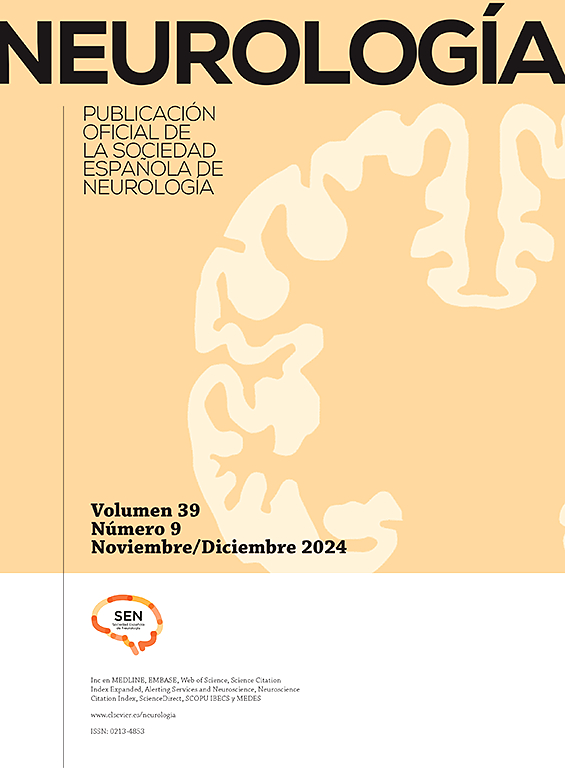家族性多发性硬化症患者TNFRSF1A基因变异rs4149584 (R92Q
IF 3.1
4区 医学
Q2 CLINICAL NEUROLOGY
引用次数: 0
摘要
基因组研究已经确定了许多与多发性硬化症(MS)易感性相关的遗传变异;然而,每一种都只能解释患病风险的一小部分。这些变异位于参与特定途径的基因中,这支持了发生MS的风险可能与这些途径的改变有关的假设,而不是与特定基因有关。我们分析了TNFRSF1A基因的作用,该基因编码TNF-α受体之一,参与先前与自身免疫性疾病相关的信号通路。方法研究了来自23个家族的138名个体,其中至少有2名成员患有MS,通过全外显子组测序分析TNFRSF1A外显子变异的存在。我们还进行了功能研究,分析变异rs4149584 (-g)的致病机制。6442643 c比;G, NM_001065.4: c.362G比;A, R92Q)质粒转染人少突胶质细胞(HOG)细胞,其行为类似于少突胶质细胞谱系细胞;蛋白质标记用于定位细胞内的蛋白质。我们还分析了转染的HOG细胞增殖和分化为少突胶质细胞的能力。结果在2例MS患者(3.85%)、1例自身免疫性疾病患者(7.6%)和5例未受影响的个体(7.46%)中发现变异rs4149584。2例MS患者和变异rs4149584为纯合子携带者,属于同一家族,其余个体为杂合子变异。对转染该突变的HOG细胞的研究表明,该蛋白不到达细胞膜,而是在细胞质中积累,特别是在内质网和细胞核附近;这表明,在呈现突变的细胞中,TNFRSF1不作为跨膜蛋白,这可能会改变其信号通路。细胞增殖和分化的研究发现,转染后的细胞继续能够分化为少突胶质细胞,并且可能仍然能够产生髓磷脂,尽管它们的增殖率低于野生型细胞。结论变异rs4149584与MS发生风险相关。我们分析了其在少突胶质细胞谱系细胞中的功能作用,并在纯合携带者中发现了与MS的关联。然而,相关的分子改变不影响向少突胶质细胞的分化;因此,我们无法确认该变异是否单独在MS中致病,至少在杂合子中是如此。本文章由计算机程序翻译,如有差异,请以英文原文为准。
Variant rs4149584 (R92Q) of the TNFRSF1A gene in patients with familial multiple sclerosis
Introduction
Genomic studies have identified numerous genetic variants associated with susceptibility to multiple sclerosis (MS); however, each one explains only a small percentage of the risk of developing the disease. These variants are located in genes involved in specific pathways, which supports the hypothesis that the risk of developing MS may be linked to alterations in these pathways, rather than in specific genes. We analyzed the role of the TNFRSF1A gene, which encodes one of the TNF-α receptors involved in a signaling pathway previously linked to autoimmune disease.
Methods
We included 138 individuals from 23 families including at least 2 members with MS, and analyzed the presence of exonic variants of TNFRSF1A through whole-exome sequencing. We also conducted a functional study to analyze the pathogenic mechanism of variant rs4149584 (-g.6442643C > G, NM_001065.4:c.362 G > A, R92Q) by plasmid transfection into human oligodendroglioma (HOG) cells, which behave like oligodendrocyte lineage cells; protein labeling was used to locate the protein within cells. We also analyzed the ability of transfected HOG cells to proliferate and differentiate into oligodendrocytes.
Results
Variant rs4149584 was found in 2 patients with MS (3.85%), one patient with another autoimmune disease (7.6%), and in 5 unaffected individuals (7.46%). The 2 patients with MS and variant rs4149584 were homozygous carriers and belonged to the same family, whereas the remaining individuals presented the variant in heterozygosis. The study of HOG cells transfected with the mutation showed that the protein does not reach the cell membrane, but rather accumulates in the cytoplasm, particularly in the endoplasmic reticulum and near the nucleus; this suggests that, in the cells presenting the mutation, TNFRSF1 does not act as a transmembrane protein, which may alter its signaling pathway. The study of cell proliferation and differentiation found that transfected cells continue to be able to differentiate into oligodendrocytes and are probably still capable of producing myelin, although they present a lower rate of proliferation than wild-type cells.
Conclusions
Variant rs4149584 is associated with risk of developing MS. We analyzed its functional role in oligodendrocyte lineage cells and found an association with MS in homozygous carriers. However, the associated molecular alterations do not influence the differentiation into oligodendrocytes; we were therefore unable to confirm whether this variant alone is pathogenic in MS, at least in heterozygosis.
求助全文
通过发布文献求助,成功后即可免费获取论文全文。
去求助
来源期刊

Neurologia
医学-临床神经学
CiteScore
5.90
自引率
2.60%
发文量
135
审稿时长
48 days
期刊介绍:
Neurología es la revista oficial de la Sociedad Española de Neurología y publica, desde 1986 contribuciones científicas en el campo de la neurología clínica y experimental. Los contenidos de Neurología abarcan desde la neuroepidemiología, la clínica neurológica, la gestión y asistencia neurológica y la terapéutica, a la investigación básica en neurociencias aplicada a la neurología. Las áreas temáticas de la revistas incluyen la neurologia infantil, la neuropsicología, la neurorehabilitación y la neurogeriatría. Los artículos publicados en Neurología siguen un proceso de revisión por doble ciego a fin de que los trabajos sean seleccionados atendiendo a su calidad, originalidad e interés y así estén sometidos a un proceso de mejora. El formato de artículos incluye Editoriales, Originales, Revisiones y Cartas al Editor, Neurología es el vehículo de información científica de reconocida calidad en profesionales interesados en la neurología que utilizan el español, como demuestra su inclusión en los más prestigiosos y selectivos índices bibliográficos del mundo.
 求助内容:
求助内容: 应助结果提醒方式:
应助结果提醒方式:


